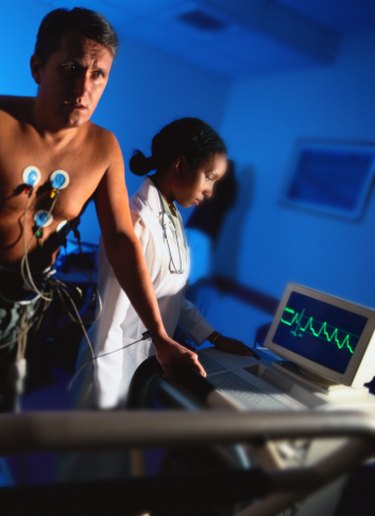
A treadmill test, also known as an exercise stress test, an exercise tolerance test, an exercise EKG or an exercise electrocardiogram, is usually requested by your doctor to provide information on how your heart responds to exercise. It allows a medical professional to gauge the duration and intensity of exercise you can safely manage. Follow recommendations about food and drink consumption the day before and on the day of the test, as well as how to take medications.
Preparing For the Test
Video of the Day
On the day before the test, take any prescription medications on the normal schedule unless told otherwise by your doctor. Increase your fluid intake and go to bed on time. If you have diabetes, speak with your doctor about taking your medication. For morning tests, do not eat or use any tobacco products after midnight. If your test is in the afternoon, a light breakfast is allowed before 9 a.m., with nothing to eat afterward. For both morning and afternoon tests, don't drink any caffeine or alcohol, drink nothing within 4 hours of the test, and avoid exercise or physical exertion before the test.
Video of the Day
Why You Need to Fast
There are different ways of monitoring your heart as you do the test. Sometimes medication is administered to facilitate the test, and any caffeine in your system may interact negatively with the medicine. Eating can cause problems with imaging data because of the need for increased blood flow to your stomach. One side effect of the treadmill test for some individuals is nausea, a problem that would only be exacerbated by having food in your stomach.
Diabetes
For those taking oral medication, if your doctor advises you to take your medicine, you can use a small amount of water to facilitate this. Since you must fast, however, you typically would not be taking your insulin or other diabetes medication. Work closely with your doctor to minimize the effect of the lack of food on your blood sugar levels.
Doing the Test
An electrocardiogram will record your heart response, and your blood pressure will be monitored while you walk on a treadmill. Both the speed and incline of the treadmill will increase steadily, and you will keep exercising until one of the following happens: You reach the target heart rate set by your doctor; you start experiencing discomfort such as chest pains; your blood pressure changes drastically; or the electrocardiogram results indicate that your heart muscle is oxygen-deprived. If medication is to be used, it is given when you are exercising at your maximum rate. Once the test is complete, you will be monitored until your heart rate normalizes. It is important to follow the pretest fasting guidelines to maximize the amount of information that can be gleaned from the test.
Is this an emergency? If you are experiencing serious medical symptoms, please see the National Library of Medicine’s list of signs you need emergency medical attention or call 911.